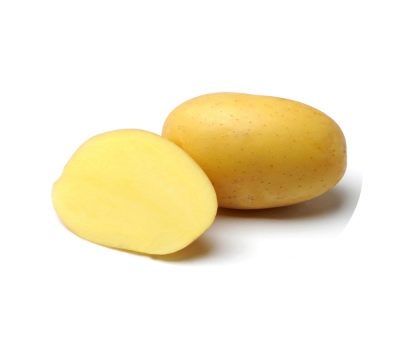
- Authors: Bohm Heinrich, Germany (Europlant Pflanzenzucht GMBH)
- Name synonyms: Nandina
- Year of approval: 2015
- Appointment: dining room
- Tuber weight, g: 72-132
- Peel color: yellow
- Color of the pulp: yellow
- Starch content,%: 12,8-15,0%
- Consistency: predominantly firm texture
- Tuber shape: oval-rounded
Ultra-early potato varieties are a godsend for every gardener. The main thing is to choose a variety that quickly adapts to the growing environment. An ideal early variety for cultivation in the Central Region and many others will be German-bred Nandina potatoes.
Breeding history
The ultra-early Nandine variety was created by the German breeders group Europlant Pflanzenzucht in 2012. The nightshade crop was approved for use and entered into the State Register of Breeding Achievements in 2015. Recommended for growing in the following regions: North Caucasian, Volgo-Vyatka and Central.
Description of the variety
Nandina is a medium-sized variety with a semi-erect type bush, characterized by moderate thickening with large green leaves, as well as a developed rhizome. At the time of flowering, large pale purple flowers with a red tint inside are formed on the bushes. As a rule, the bushes bloom in the second half of May.
Characteristics of the appearance of the bush and root crops
Up to 10-12 tubers are formed on one bush, and practically without small specimens. The shape of the vegetable is correct - oval-round. The surface is smooth, slightly shiny. Tubers weighing from 72 to 132 grams are ripened. The peel of a vegetable is of medium density, not very densely covered with small and shallow eyes. The color of the potato is uniform - light yellow.
The dug tubers can be transported over long distances, as well as stored for a long period in cool conditions and not excessively damp.
Purpose and taste of tubers
German potatoes are renowned for their great taste. The yellow flesh has a dense, oily consistency without wateriness. The vegetable has a pleasant, deep taste. When peeling, slicing and boiling, the pulp does not darken. Boiled tubers do not boil over, do not crumble. Potatoes contain up to 15% starch and many useful components: vitamins B, K, C, E, beta-carotene and magnesium, potassium, calcium, iron, zinc.
Potatoes have an almost universal purpose: they are boiled in a peel, peeled for salads, added to first courses, fried and baked. In addition, the tubers are ideal for consumption as young potatoes.
Maturation
Nandina represents a class of super early varieties. It takes only 45-60 days from the mass appearance of sprouts to digging up. The first digging can be carried out after 35-45 days, having received tubers with a thin skin to boil whole. Full harvesting occurs in the second half of June (if planting is done before mid-April).
Yield
The yield indicators for this species are good. On average, from 1 hectare of beds, you can dig up from 146 to 322 centners of tubers. The maximum yield was recorded at the level of 329 centners per hectare of soil. With intensive agricultural technology, you can get a double or triple harvest by planting a crop immediately after digging the tubers.
Growing and care
The planting of the culture is carried out from April 10 to mid-May, depending on the growing region. The planting material is pre-processed, sprouts are allowed to appear, and are treated with growth stimulants.Potatoes are planted during a period when the temperature regime has stabilized (+ 10-12 degrees), and return spring frosts are left behind. The optimal scheme is 30x70 cm.
The variety is distinguished by its unpretentious care. The plant requires timely watering, hilling bushes, weeding between beds, removing weeds, loosening the topsoil, applying fertilizers, and preventing disease. Experienced gardeners recommend mulching using straw or hay, which will slow down the appearance of weeds.

Planting potatoes is one of the main spring activities traditional for Russian gardeners. There are many ways to plant this vegetable, allowing you to get a good harvest in different conditions and climates. Before planting, you need to carefully prepare the planting material, correctly determine the timing, competently prepare the soil.


Soil requirements
Peat, forest and sandy loam soils are ideal for nightshade culture. It is not recommended to grow the German variety on black soil and heavy soils. The soil should be well cultivated, breathable, moisture-permeable, fertile, without moisture stagnation and with a neutral acidity index.

Required climatic conditions
Potatoes are a culture that loves warmth, light, easily tolerates drought, so a site for planting is chosen well-lit by the sun, protected from cold winds and with deep groundwater.
Disease and pest resistance
Nandina has an excellent immune system that provides resistance to many viruses, potato crayfish, nematodes, wrinkled and banded mosaics, and common scab. The only disease to which the variety does not have resistance is late blight of tubers and leaves. Among the insect pests that attack potato bushes, the most dangerous are the Colorado potato beetle and wireworm, which treatments will help get rid of.

Potatoes are a popular vegetable crop that many gardeners planted on their site. But it is unlikely that it will be possible to grow a bountiful harvest of tasty and large tubers if the beds are not properly protected from the most common diseases and pests. Often, the development of diseases of various etiologies of potatoes goes unnoticed, so it is important to identify the problem in time and eliminate it.
















































































